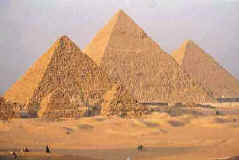
The Tekenu is one of the funerary procession elements. It appeared since the OLD KINGDOM in tomb representations in many positions:
- A completely wrapped container so that any resemblance to a human figure is not apparent.

- A container with a human face just showing through a shroud and sitting upon a sledge.
- a human shape in a prone position on a sledge without shroud in a fetal position of a typical pre-dynastic burial.


- a human shape on a couch with only his head protrudes from a cocoon-like shroud

The Tekenu has not been completely explained but many conceptions discussed what the Tekenu is :
- An animal leathered container which contains the spare body parts that were left over during the mummification.
- A representation of the deceased as an embryo in a womb preparing to be reborn as a denotion for the resurrection.
- A shape for the deceased's ( KA ) and may be this role was played by the ( SEM ) priest so as to denote the resurrection when the priest enters the tomb and rise up from his crouching posture.
- A symbolic representaion of human sacrifice but this conception proved to be wrong as there's no trace for human sacrifice in the Ancient Egyptian civilization.
References

 Since the Old Kingdom, the Mourning representations always appeared in the funeral procession scenes as the deceased was accompanied on the way to his tomb by 2 female Mourners, one at his head and the other at his feet, represnting goddesses ( ISIS ) & ( NEPHTYS) bewailing the while searching for god's ( WSIR ) coffin { after his brother, god ( SET ) locked him in a coffin throwing it into nile } till they found it in BYBLOS.
Since the Old Kingdom, the Mourning representations always appeared in the funeral procession scenes as the deceased was accompanied on the way to his tomb by 2 female Mourners, one at his head and the other at his feet, represnting goddesses ( ISIS ) & ( NEPHTYS) bewailing the while searching for god's ( WSIR ) coffin { after his brother, god ( SET ) locked him in a coffin throwing it into nile } till they found it in BYBLOS. 
 Men rarely or never showed their sorrow and Blue was occasionally the prescribed colour for Mourning dress.
Men rarely or never showed their sorrow and Blue was occasionally the prescribed colour for Mourning dress. 